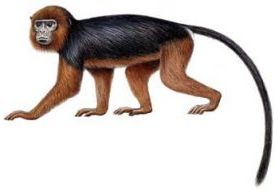Miss Waldron's Red ColobusProcolobus badius waldroni (Hayman, 1936) Ghana and Côte d’Ivoire (2000, 2002, 2006)
|
|
|
Miss Waldron’s red colobus, P. badius waldroni, of western Ghana and eastern Côte d’Ivoire is teetering on the very brink of extinction (Struhsaker 1999; Oates et al. 2000; Groves 2001; Grubb et al. 2003). Primatologists have searched its known range since 1993, but have failed to see a living animal (Oates et al. 1996/1997; McGraw 1998, 2005; McGraw and Oates 2002). A single skin found in the possession of a hunter near the Ehy Lagoon in southeastern Côte d’Ivoire in early 2002 raised hopes that at least one population of Miss Waldron’s red colobus still hangs on, but subsequent fieldwork in this region, including several forest reserves and nearby Isles Ehotiles National Park, has yielded no evidence of living individuals (Kone 2004; Kone and Akpatou 2005; McGraw 2005; Kone et al. 2007). Through a partnership of Conservation des Espèces et des Populations Animales (CEPA) and the Centre Suisse de Recherches Scientifiques en Côte d’Ivoire (CSRS), Kone et al. (2007) surveyed 14 forest reserves in Côte d’Ivoire between 2004 and 2006, including Isles Ehotiles National Park. These surveys failed to provide any sightings of Miss Waldron’s red colobus, only a claim of a single vocalization in Ehotiles in 2006. The forest adjacent to the Ehy Lagoon has not been surveyed since 2002, when no red colobus were found. However, the Ehy forest seems to be the only place in Côte d’Ivoire where a small population of Miss Waldron’s red colobus might hang on. The forest is under heavy poaching pressure from Ivorian and Ghanaian hunters, and it is being logged, but Kone et al. (2007) have begun an awareness and education campaign in the villages there. Their plans are to build a community-based conservation system centered on the eight villages surrounding the lagoon. A thorough survey of the forest is needed as a matter of urgency. In Ghana, very recent surveys (Oates 2006) support earlier suspicions that this monkey is almost certainly extinct in that country (Oates et al. 1996/1997; Struhsaker and Oates 1995). If any animals have managed to survive, the numbers must be very small and it will take heroic efforts to preserve them. Many forms of red colobus are endangered, including three other forms in West Africa: Pennant’s red colobus (Procolobus pennantii pennantii) of Bioko Island (see profile in this report), Preuss’s red colobus (P. p. preussi) of Cameroon, and the Niger River Delta red colobus (P. p. epieni). In addition, Bouvier’s red colobus (P. p. bouvieri) from the Congo Republic has not been seen by scientists for at least 30 years. The plight of these monkeys highlights threats faced by red colobus generally; they have patchy distributions, have suffered extensive habitat degradation and are particularly vulnerable to hunters (Wolfheim 1983; Oates 1996; Grubb and Powell 1999; Oates et al. 2000; Struhsaker 2005). Implementation of a red colobus action plan should be a high conservation priority in Africa. W. Scott McGraw & John F. Oates |
|
References Groves, C. P. 2001. Primate Taxonomy. Smithsonian Institution Press, Washington, DC. Grubb, P., T. M. Butynski, J. F. Oates, S. K. Bearder, T. R. Disotell, C. P. Groves and T. T. Struhsaker. 2003. An assessment of the diversity of African primates. Int. J. Primatol. 24: 1301–1357. Grubb, P. and C. B. Powell. 1999. Discovery of red colobus monkeys (Procolobus badius) in the Niger Delta with the description of a new and geographically isolated subspecies. J. Zool., Lond. 248: 67–73. Kone, I. 2004. Report on recent primate surveys in the southeast of Ivory Coast. Report, Conservation des Espèces et des Populations Animales (CEPA), Schlierbach, France. Kone, I. and K. B. Akpatou. 2005. Identification des sites abritant encore les singes Cercopithecus diana roloway, Cercocebus atys lunulatus et Piliocolobus badius waldroni en Cote d'Ivoire. Report, Conservation des Espèces et Populations Animales (CEPA), Schlierbach, France. Kone, I., D. Coulibaly, K. Bene, A. Bitty, A. Koffi, A. Boko and R. Kouadio. 2007. Initiation of a community based conservation system in southeastern Cote d'Ivoire for the probable last refuge for the Miss Waldron's red colobus. Report, West African Primates Conservation Action, Abidjan, Côte d’Ivoire. McGraw, W. S. 1998. Three monkeys nearing extinction in the forest reserves of eastern Cote d’Ivoire. Oryx 32: 233–236. McGraw, W. S. 2005. Update on the search for Miss Waldron’s red colobus monkey (Procolobus badius waldroni). Int. J. Primatol. 26(3): 605–619. McGraw, W. S. and J. F. Oates. 2002. Evidence for a surviving population of Miss Waldron’s red colobus. Oryx 36:223–226. Oates, J. F. 1996. African Primates: Status Survey and Conservation Action Plan. Revised Edition. IUCN/SSC Primate Specialist Group, Gland, Switzerland. 80pp. Oates, J. F. 2006. Primate Conservation in the Forests of Western Ghana: Field Survey Results, 2005–2006. Report to the Wildlife Division, Forestry Commission, Ghana. Oates, J. F., T. T. Struhsaker and G. H. Whitesides. 1996/1997. Extinction faces Ghana’s red colobus and other locally endemic subspecies. Primate Conserv. (17): 138–144. Oates, J. F., M. Abedi-Lartey, W. S. McGraw, T. T. Struhsaker and G. H. Whitesides. 2000. Extinction of a West African red colobus monkey. Conserv. Biol. 14: 1526–1532. Struhsaker, T. T. 1999. Primate communities in Africa: The consequence of long-term evolution or the artifact of recent hunting? In: Primate Communities, J. G. Fleagle, C. Janson and K. E. Reed (eds.), pp.289–294. Cambridge University Press, Cambridge, UK. Struhsaker, T. T. 2005. The conservation of red colobus monkeys (Procolobus) and their habitats. Int. J. Primatol. 26(3): 525–538. Struhsaker, T. T. and J. F. Oates. 1995. The biodiversity crisis in southwestern Ghana. African Primates 1: 5–6. Wolfheim, J. H. 1983. Primates of the World. University of Washington Press, Seattle. Suggested citation: McGraw, W. S. and Oates, J. F. 2007. Miss Waldron's Red Colobus, Procolobus badius waldroni (Hayman, 1936). In: Primates in Peril: The World’s 25 Most Endangered Primates 2006–2008, R. A. Mittermeier et al. (compilers), p.10. Unpublished report, IUCN/SSC Primate Specialist Group (PSG), International Primatological Society (IPS), and Conservation International (CI), Arlington, VA. |



